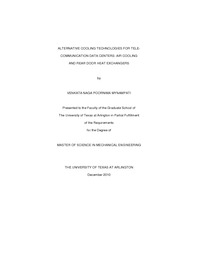| dc.contributor.author | Mynampati, Venkata Naga Poornima | en_US |
| dc.date.accessioned | 2011-03-03T21:50:52Z | |
| dc.date.available | 2011-03-03T21:50:52Z | |
| dc.date.issued | 2011-03-03 | |
| dc.date.submitted | January 2010 | en_US |
| dc.identifier.other | DISS-10874 | en_US |
| dc.identifier.uri | http://hdl.handle.net/10106/5379 | |
| dc.description.abstract | Telecommunication industry is currently emphasizing to a miniaturization and convergence. The need for smaller, smarter and faster devices is leading drastic increment in power density and accordingly, thermal management of such devices has become a challenge. The heat generated by the devices has to be dissipated in order to ensure proper and efficient functioning of the electronics. Electronics cooling ranges from device level to the room level cooling. Data Center is a facility (room) consisting of servers used for managing and transferring data or information. The thermal management of this facility is challenging due to the huge decrease in floor space for equipment and a tremendous increase in the power density of the servers without a compromise in the energy efficiency. The increase in server heat density waves a scope for developing improved cooling technologies without increasing the power consumption. It is commonly observed that 40% of the total data center energy is consumed by its cooling equipments. In our application, thermal management through air cooling is possible to a maximum of 16kW. Beyond 16kW, typical air cooling techniques leads to a substantial increase in the power consumption hence, a concept of hybrid cooling using Rear Door Heat Exchanger (RDHx) is incorporated. RDHx is used for higher server density cabinets up to 25kW which helps in reducing the power consumption and efficient cooling. This study is therefore divided into two parts: air cooling and hybrid cooling.In air cooling of Data center, suitable cooling accessories for various heat loads of the cabinets in a data center are determined. The accessories include the blanking panels and chimneys. Furthermore, impact of hot/cold air isolation is analyzed for high heat loads of the cabinets. It is observed that the accessories are effective for heat loads up to 12kW and the hot/cold air containment is effective for 16kW.Furthermore, in case of RDHx, emphasis is placed on the analytical determination of the optimum heat load after determining the effectiveness of heat exchanger at the given operating conditions. Then, thermal analysis is performed to compare various heat loads of the cabinets with RDHx. Based on the results; a `best known method' or `rule of thumb' is verified that rear door heat exchanger could be 100% efficient in cooling the cabinets of heat loads up to 27kW. The impact of RDHx in different configurations is studied and compared. A computational study of the effectiveness of RDHx in side breathing network switches is analyzed. It is seen that there is a decrease in the global maximum temperature with the inclusion of RDHx and they are very effective in cooling the side breathing switches. | en_US |
| dc.description.sponsorship | Agonafer, Dereje | en_US |
| dc.language.iso | en | en_US |
| dc.publisher | Mechanical Engineering | en_US |
| dc.title | Alternative Cooling Technologies For Telecommunication Data Centers: Air Cooling And Rear Door Heat Exchangers | en_US |
| dc.type | M.S. | en_US |
| dc.contributor.committeeChair | Agonafer, Dereje | en_US |
| dc.degree.department | Mechanical Engineering | en_US |
| dc.degree.discipline | Mechanical Engineering | en_US |
| dc.degree.grantor | University of Texas at Arlington | en_US |
| dc.degree.level | masters | en_US |
| dc.degree.name | M.S. | en_US |

